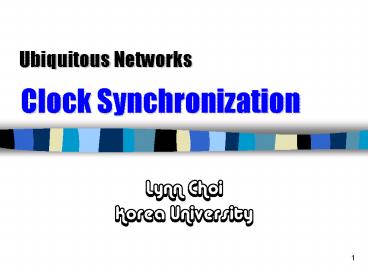Lynn Choi - PowerPoint PPT Presentation
1 / 12
Title:
Lynn Choi
Description:
Elimination/integration of redundant data from multiple sensors ... A server periodically sends a message containing its current clock value to a client ... – PowerPoint PPT presentation
Number of Views:124
Avg rating:3.0/5.0
Title: Lynn Choi
1
Ubiquitous Networks Clock Synchronization
- Lynn Choi
- Korea University
2
Why do we need to synchronize clocks?
- Data fusion
- Elimination/integration of redundant data from
multiple sensors - Synchronization for networking protocols
- Wakeup scheduling for low power consumption
- Slot time, interframe spacing, timeouts
- TDMA scheduling
- Event ordering
- The relative ordering (or time interval) between
two events that happened on different machines in
the network - Localization (ToA, TDoA)
- Cooperative operation by multiple sensors
- Velocity estimate of a moving object
- Measure the time-of-flight of sound
3
Requirements in Sensor Network
- Energy efficiency
- Need to consider energy efficiency without
external energy source - Scalability scalable to a large number of nodes
- Accuracy and precision
- Depend on the objectives and the applications
- Robustness
- Fault-tolerant, without human involvement
- Scope
- Local or global
- Cost and size
- must be applicable to low-cost sensors
- Limited bandwidth, limited computation power and
storage space
4
Clock Model
- Characteristics of crystal oscillators
- Accuracy
- The difference between the expected frequency and
actual frequencies. This difference is called the
frequency error, whose maximum is specified by
the manufacturer. - The maximum error is in the range of one part in
104 to 106, which translates to 1 100 µs/s. - Two Berkeley Motes may have 4.75 µs/s of skew at
the maximum, which leads to 17.1ms after 1 hour
and 1 second after 58 hours - Stability
- An oscillators tendency to stay at the same
frequency. - Short-term instability is caused by environmental
factors such as temperature, supply voltage, and
shock - Long-term instability is caused by oscillator
aging.
5
Clock Model
- Clock can be modeled by drift and offset
- Drift (skew) denotes the rate (frequency) of the
clock - Offset (or phase offset) denotes the difference
in value from the real time t - For a node i in the network, its local clock can
be represented as - Ci(t) ait bi
- where ai(t) denotes the clock skew
and - bi(t) is the offset
of node is clock. - Using the equation, we can compare the local
clocks of two nodes as - C1(t) a12 C2(t) b12
- Where a12 denotes the relative drift and b12
denotes the relative offset. - If two clocks are perfectly synchronized, then
their relative drift is 1 and the relative offset
is zero
6
Distributed Time Synchronization
- All network time synchronization schemes rely on
some message exchanges between nodes - Nondeterminism in the network makes the
synchronization task challenging - Sources of time synchronization errors
- Send time
- Time required to transfer the message from the
host to its network interface - Access time
- Time waiting for access to transmit the message
- Propagation time
- This time is very small (1ns/foot) and can be
ignored - Receive time
- The time required for the network interface to
generate a message reception signal
7
Existing Algorithms
- They vary primarily in their methods for
estimating and correcting for these sources of
errors - NTP performs a large number of request/response
messages to filter random delays (i.e. shortest
round-trip time) - Most share a basic design
- A server periodically sends a message containing
its current clock value to a client - If the typical latency from a server to a client
is small compared to the desired accuracy, a
simple one-way message is enough - A common extension is to use a client request
followed by a servers response. - By measuring the round-trip time of two packets,
the client can estimate the one-way latency
8
Remote Clock Reading (Cristian, 1989)
9
Offset Delay Estimation (used by NTP)
10
NTP (Network Time Protocol)
- Hierarchy of NTP servers
- Primary server at the root synchronizes with the
UTC - A node synchronizes with its parent by performing
several trials of offset delay estimation and
choose the offset with the minimum delay (to
compensate for the delay variance) - The reported accuracy of NTP
- 1 50ms (1ms for LAN, 28.7ms for WAN)
- Others
- SNTP (Simple NTP)
- Less accurate, but simpler
- IEEE 1588
- For measurement and control on small networks
- Only for synchronization within subnet (no
router) - Accuracy of several hundred nanoseconds
- GPS
- Accuracy of 10ns
11
Synchronization Protocols for WSN
- RBS (Reference Broadcast Synchronization),
OSDI,2002 - Receiver to receiver synchronization (no
timestamp) - A message broadcast at the physical layer will
arrive at a set of receivers with very little
variability in its delay - Transmitter broadcasts a reference packet to two
receivers - Each receiver records the reception time
according to its local clock - The receivers exchange their observations
- Eliminate the largest sources of error (send time
and access time) from the critical path - Issues O(n2) message exchanges for a single-hop
network of n nodes
NTP
RBS
12
Synchronization Protocols for WSN
- TPSN (Timing Sync Protocol for Sensor Networks),
Sensys 2003 - Sender to receiver synchronization (with
timestamp) - Level discovery phase create a tree
- Synchronization phase two-way message exchange
(offset delay estimation) starting from the root - Claims that uncertainty at the sender contributes
little to the total synchronization error and
they can outperform RBS - Lightweight synchronization schemes for WSN
- Tiny-Sync Mini-Sync, WCNC 2003
- LTS (Lightweight Tree-based Synchronization),
WSNA 2003































